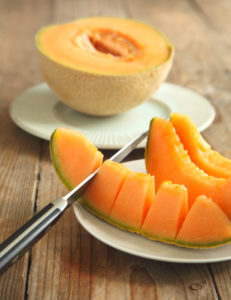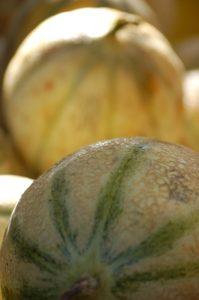 It’s the time of year for making the most of melons as they hit their seasonal stride.
It’s the time of year for making the most of melons as they hit their seasonal stride.
The hotter months bring those big round fruits to our tables, and smiles to our faces, which by that time may need to be wiped clean from dripping juices of this luscious summertime treat. You need no more than a knife to open up these beauties, then you can literally pass round the slices and get down to businesses gnawing the flesh from the rind. The slices are even shaped like a smile.
Melons have been around a long time, originating in Africa, spread around their empire by the Romans, with melon seeds taken to the Americas with the settlers. As a result, many areas now have a specific variant of melon to call their own.
There’s even a winter melon, which goes by many names such as winter gourd, ash gourd, while or tallow gourd or Chinese preserving melon. It is more widely used in cooking, particularly in Asia. In India, where it’s know as the ash gourd, it is recognized for its medicinal properties in the Ayurvedic system of medicine.
 A melon is any of various plants of the family Cucurbitaceae, which includes cucumber, pumpkin and squash. Botanically, a melon is a kind of berry, specifically a ‘pepo’.
A melon is any of various plants of the family Cucurbitaceae, which includes cucumber, pumpkin and squash. Botanically, a melon is a kind of berry, specifically a ‘pepo’.
Best from May to August in the UK, the main ones we know here are the honeydew, galia, watermelon and canteloup. Low in calories, there’s some carb content, with the canteloup being more sugary than the watermelon but generally all are of a medium glycaemic index, so pretty good for people with diabetes though eat in moderation as it will raise your blood glucose. These fruits are low in sodium, calories and fat and are cholesterol free. The natural sweetness could curb cravings for sugary foods and high calorie sweets. Watermelon, in particular, is good for weight loss as a whole cup provides just 48 calories. An extra benefit of melon is that’s it’s supposed to be good for the skin, as it contains collagen, plus the vitamins it contains are skin-healthy. You can literally cut slices to lay on your skin and relax for a while before rinsing off, leaving your skin with a healthy glow.
Classic combo
Flavour-wise, melon works well with mint, ginger and cucumber. As very big berries themselves, melons also work well with strawberries and raspberries. Melons can be used for granites and sorbets, but for those you’d be adding in sugar, which seems a shame when they are fairly sweet to begin with. Food writer Diana Henry recalls having had a charentais melon (a type of French canteloup) with its hollow filled with raspberries or ice-cold muscat, which both sound rather lovely. You can even make a pickle from watermelon rind, boiling it until it is transparent with sugar and flavours like ginger or lemon then preserving in glass jars.
 Melon with Parma ham is a traditional Italian appetizer, known simply as ‘prosciutto melone’. Two basic, simple ingredients can be dressed up to look great. Either slice melon into thin slices and wrap with a thin sheet of Parma ham, or you can cut the melon into squares and wrap those, or even make melon balls and skewer those with a little bit of folded ham, and you can add on a small ball of mozzarella or even some fig. Invert the whole idea and you can line a bowl with the Parma ham and fill it with small cubes of melon and rocket, basil or mint can work as a garnish (not altogether!).
Melon with Parma ham is a traditional Italian appetizer, known simply as ‘prosciutto melone’. Two basic, simple ingredients can be dressed up to look great. Either slice melon into thin slices and wrap with a thin sheet of Parma ham, or you can cut the melon into squares and wrap those, or even make melon balls and skewer those with a little bit of folded ham, and you can add on a small ball of mozzarella or even some fig. Invert the whole idea and you can line a bowl with the Parma ham and fill it with small cubes of melon and rocket, basil or mint can work as a garnish (not altogether!).
The nutritional content of Melon: Per 110g, calories 36, no fat, no cholesterol, no potassium, teeny bits of potassium, 9g of carbs, little bit of fibre. However, it has a whopping big dose of Vitamin C (30% RDA), and 5% of Vitamin B-6.
News items and features like this appear in the Desang Diabetes Magazine, our free-to-receive digital journal. We cover diabetes news, diabetes management equipment (diabetes kit) and news about food suitable for a diabetic diet. Go to the top of this page to sign up – we just need your email address.



